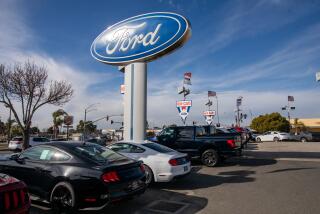Considering a New Car? Consider the Cost First : Autos: Factor in the ticket price, depreciation and anticipated expenses to determine the best deal for your dollar.
- Share via
It runs like a dream, starts in the dead of winter and does a comfortable 65 m.p.h. with nary a shake. But it’s 4 years old, doesn’t have a sunroof and, well, red is no longer your color.
When is it time to sell the car and plunk down many grand for a new model? Or when should you hold on to a good thing?
Put aside, if you can, the subjective considerations of image, comfort and the desire for something new. That’s a whole different story. For most, buying a new car or keeping the old one is a decision based on cost.
If money is not an issue, don’t read on and head down to your local car dealer. If dollars do count, go get a pencil and paper.
Using a financial analysis developed by consultants at Runzheimer International, consumers can decide whether to sell or hold, based not only on the resale value of their car but what the car will cost in real dollars over time.
Let’s say you own a 1991 six-cylinder, four-door sedan. The car you are considering buying is a 1995 six-cylinder, four-door sedan. Your car cost $14,493 and gets 21 miles to the gallon. The new car costs $17,359 and gets 21 m.p.g.
Your current car is paid for, and you’ll have to finance the new one with a four-year loan at 8.5% annual interest. The down payment for the new car is the trade-in value of the old one.
“This is not an unusual decision to make, whether to sell or hold, because it’s a depreciable asset that costs a lot of money,” said Lee Czarapata, of Rochester, Wis.-based Runzheimer.
“The new car payments are the decisive factors. Even through the newer model car has a much greater trade-in value after four years and you save on repairs and maintenance, the monthly car payments, which total slightly over $16,500 in principal and interest over four years, more than counterbalance the factors.”
In Runzheimer’s analysis, the 1991 model’s total costs after four years--payments, fuel, licenses and repairs--would be about $12,308.
The new car, four years from now, will have cost $27,361, including those expenses plus the cost of principal and interest on the loan.
Over four years, the 1991 model requires $100 more for fuel and oil (totaling $3,580), and $2,231 more ($4,449) for repairs, maintenance and tires.
“Keeping an older car opens you to more breakdowns and maintenance,” Czarapata said. “Not that they are unsafe, but they are less reliable.”
After four years, the resale value of the 1991 car will be $213, while the 1995 will get about $6,147.
But remember, depreciation, or the reduction in value of the car over time, is greatest in the first year and is very little after six or seven, depending on the number of miles on the car.
Total savings: $9,119 by 1998 if you keep your 1991 model rather than buy the 1995.
The bottom line? “If reliability is not a factor, keep the old car,” Czarapata said.
Potential purchasers can do their own analyses, taking the cost of an old car or a new one, depreciation and anticipated costs, drawing them out over four years and determining whether there will be significant savings.
Experts advise checking out sources such as Consumer Reports magazine, not only for research on new models, but also for feedback on the old.
“It’s good to know what happened with other people,” Czarapata said. “That way you can make an intelligent choice.”
The typical life span of a car is six or seven years but can be longer given improvements in the quality of the bodies and engine parts.
Typically, Americans buy a new vehicle every four years. But holding onto the old one--and springing for the cost of a new paint job if you must--can save as much as $9,000. No small change.






